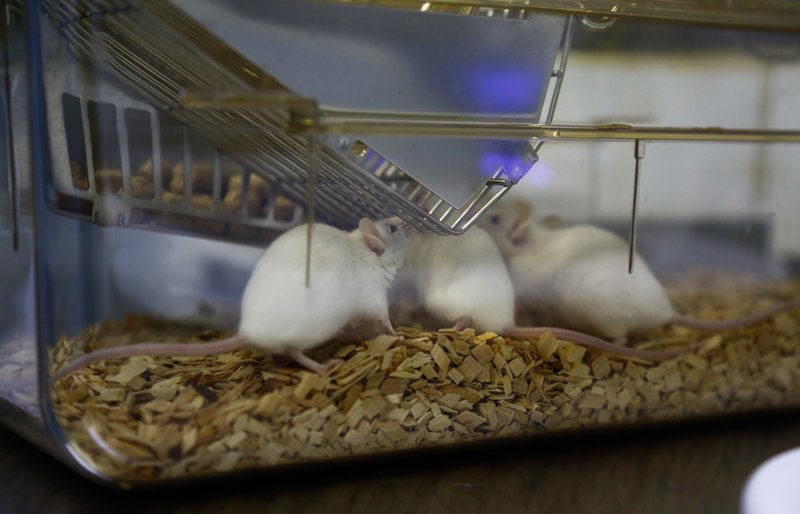首例双父小鼠惨死,繁殖方法或可用于拯救濒危物种

|
利用近几年出现的基因编辑技术,中国研究者使用两只雄性小鼠的细胞和两只雌性小鼠的细胞分别培育出了能够成活的小鼠胚胎。根据研究者向《细胞·干细胞》杂志(Cell Stem Cell)提交的报告,移植后的胚胎均发育足月,但孤雄小鼠在出生几天后就死亡。 这是首次培育出双父无母哺乳动物,此前日本研究者曾于2004年培育出双母无父小鼠。那次实验中,研究者将尚未成熟的卵子注入类似精子的细胞中,移除一对影响胚胎生长的基因。大部分新生小鼠都未能存活至成年,原因很可能是对小鼠基因进行的干扰,但其中一只雌鼠成年并孕育了后代。 像火鸡,许多爬行类动物、两栖类动物和鱼类在无法找到异性时可以自我繁衍。一些物种在当地种群雄性或雌性比例过高的情况下,甚至可以改变自己的性别以实现繁殖。 在前文所述的中国项目中,研究者使用了一种被称为CRISPR/Cas9的更加精准的基因编辑工具,因而可以删除三个会影响单性别胚胎发育的基因信息段。通过这种方式,孤雌小鼠得以生长并进行正常繁衍,但确实存在一些异常。 从两只雄性小鼠孕育胚胎需要在六个位置删除遗传物质。然而,这些外界介入导致小鼠幼崽体型异常,因体液过多造成肿胀,最终死亡时内脏破裂、舌头肿大、无法合上眼皮。它们仅仅存活了48小时。 研究者告诉《科学新闻》(Science News),他们无意在人体上进行类似实验。由于每一物种的基因密码都存在差异,这种方式在人体上可能无法成功。但如果研究者可以将上述方法运用于其它物种,或许可以用于拯救北白犀等濒危物种,目前地球上仅有两头雌性北白犀幸存。 通过在实验室研究抑制不同基因通道对胚胎会产生何种影响,也可以让研究者了解基因是如何引导正常发育的。但谈到将此用于人类研究,“这是个很大的伦理问题。”夏威夷大学的莫妮卡·沃德告诉《国家地理》(National Geographic)说。(财富中文网) 译者:庞洋 |
Using a gene-editing method that has emerged in the last few years, Chinese researchers have created viable mouse embryos using cells from two males and, separately, from two females. The implanted embryos grew to term but the male-only pups died a few days after birth, the researchers report in Cell Stem Cell. It is the first case of mammals with two fathers and no mothers, though Japanese researchers created fatherless mice with two mothers in 2004. That time, researchers converted an immature female egg into a sperm-like cell and removed a pair of genes involved in fetal growth. Most of the pups did not survive to adulthood, probably due to the interference with their genes, but one did and had pups of her own. Other animals—including turkeys and many reptiles, amphibians and fish—can self-fertilize when unable to find members of the opposite sex. Some can even change their sex in order to reproduce in the local male-heavy or female-heavy community. In the recent Chinese project, researchers used a more precise gene-editing tool called CRISPR/Cas9, which allowed them to trim three stretches of genetic information known to otherwise interfere with single-sex embryo development. The pups grown this way from two female parents grew up and had normal fertility, though they did suffer from some abnormalities. Forming embryos from two male parents required trimming more genetic material in six places. However, the interference caused those pups to grow in grotesque proportions, inflated by internal fluid until their guts leaked, their tongues swelled and they could not close their eyelids. They lived only 48 hours. The researchers have no plans to do similar experiments in humans, they told Science News. Because of differences between the genetic code in each species, it may not even work in humans. But if researchers could adapt it to other species, they might be able to help save endangered ones such as the northern white rhinoceros, of which only two females remain. Studying the effects of suppressing different genetic passages on embryos in the laboratory might also teach researchers more about how genes guide normal development. But as soon as they turn to humans, “It is really a big ethical question mark,” Monika Ward of the University of Hawai’i told National Geographic. |











